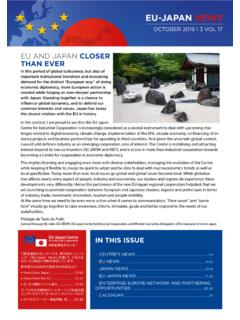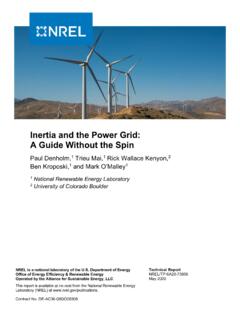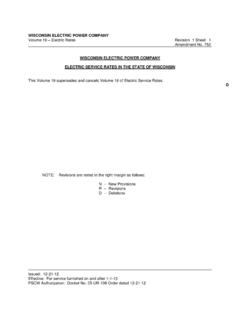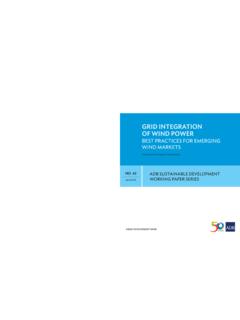Transcription of HYDROGEN AND FUEL CELLS IN JAPAN
1 HYDROGEN AND fuel CELLS IN JAPAN JONATHAN ARIAS Tokyo, October 2019 EU- JAPAN Centre for Industrial Cooperation ABOUT THE AUTHOR Jonathan Arias is a Mining Engineer (Energy and Combustibles) with an Executive Master in Renewable Energies and a Master in Occupational Health and Safety Management. He has fourteen years of international work experience in the energy field, with several publications, and more than a year working in JAPAN as an energy consultant. He is passionate about renewable energies, energy transition technologies, electric and fuel cell vehicles, and sustainability. He also published a report about solar Energy, Energy Storage and Virtual power Plants in JAPAN that can be considered the first part of this document and is available in He can be reached on LinkedIn and at ABOUT THE EU- JAPAN CENTRE FOR INDUSTRIAL COOPERATION The EU- JAPAN Centre for Industrial Cooperation ( ) is a unique venture between the European Commission and the Japanese Government.
2 It is a non-profit organisation established as an affiliate of the Institute of International Studies and Training ( ). It aims at promoting all forms of industrial, trade and investment cooperation between the EU and JAPAN and at improving EU and Japanese companies competitiveness and cooperation by facilitating exchanges of experience and know-how between EU and Japanese businesses. (c) Iwatani Corporation kindly allowed the use of the image on the title page in this document. I Table of Contents Table of Contents .. I List of Figures .. III List of Tables .. V List of Abbreviations .. VI 1. EXECUTIVE SUMMARY .. 1 2. INTRODUCTION: ENERGY SCENARIO AFTER THE GREAT EAST JAPAN EARTHQUAKE .. 3 About HYDROGEN .
3 7 3. HYDROGEN MARKET IN JAPAN .. 11 Stationary fuel CELLS .. 21 Mobility .. 32 fuel Cell Vehicles .. 34 Refueling Stations .. 43 power Generation .. 55 Co-firing of ammonia in coal power plants .. 65 Supply Chains and HYDROGEN Carriers .. 69 Energy Carriers .. 73 Liquefied HYDROGEN .. 80 From Australia s brown coal .. 81 From Norway s natural gas and renewable sources .. 84 Organic Hydride Methylcyclohexane (MCH) .. 84 From Brunei s natural gas .. 85 From Australia s solar PV energy .. 87 Ammonia .. 88 From Saudi Arabia s fossil fuels .. 90 Regional Renewable HYDROGEN Supply Chains .. 91 Main HYDROGEN Research Clusters .. 99 Fukuoka Prefecture and Kyushu University .. 99 Fukushima Prefecture and AIST, FREA .. 104 II Yamanashi Prefecture and the Yamanashi fuel Cell Valley.
4 107 Organizations and Associations .. 112 Main Private Companies .. 115 Potential Opportunities and Recommendations for European Firms .. 119 4. CONCLUSIONS .. 122 5. REFERENCES .. 124 ANNEXES .. 127 III List of Figures Figure 1: Targets for the Electric power Supply-Demand Structure in JAPAN in 2030 .. 4 Figure 2: Overview of Carbon-free Energy Storage Technologies .. 8 Figure 3: Energy System .. 9 Figure 4: Basic Scheme of HYDROGEN 11 Figure 5: Strategic Roadmap for HYDROGEN and fuel CELLS (June 2014) .. 13 Figure 6: Basic HYDROGEN Strategy (December 2017) .. 14 Figure 7: Action Plan in the Strategic Roadmap for HYDROGEN and fuel CELLS (March 2019) .. 16 Figure 8: HYDROGEN Cost Targets .. 16 Figure 9: HYDROGEN Cost Perspective of the Supply Project .. 17 Figure 10: Ongoing projects of METI and NEDO (Supply Side).
5 17 Figure 11: Ongoing projects of METI and NEDO (Demand Side).. 18 Figure 12: Operation of a fuel Cell CHP .. 21 Figure 13: Ene-farm Market Trends .. 22 Figure 14: Dissemination of Ene-farms in JAPAN . Evolution of Costs and Subsidies .. 24 Figure 15: Ene-farm Manufacturers Sales Volume Annually (only in Japanese) .. 26 Figure 16: Examples of fuel Cell for Commercial and Industrial Application .. 28 Figure 17: Share of Next-generation Vehicles in New Passenger Car Registration (in %) .. 33 Figure 18: Stock of FCEV as of end 2018 .. 35 Figure 19: Targets for the Dissemination of FCVs and HRS in JAPAN .. 35 Figure 20: How to Calculate the Subsidy for the Purchase of Clean Energy Vehicles in 2018 .. 39 Figure 21: fuel Cell Vehicles and Buses as Emergency power Source .. 40 Figure 13: Stock of HRS as of end 2018.
6 43 Figure 23: Location and Number of HRS and FCVs in JAPAN as of the end of March 2019 .. 44 Figure 18: HYDROGEN Station SimpleFuelTM .. 45 Figure 25: Members of JHyM as of May 2019 .. 51 Figure 26: JHyM s Business Scheme for HRS s Construction .. 52 Figure 27: JHyM s Business Scheme for HRS s Operation .. 53 Figure 28: power -to-Gas .. 55 Figure 29: NOx Emissions Using Water Injection during the HYDROGEN and Natural Gas Combustion .. 57 Figure 30: P2G Demonstration Project in Hokkaido .. 58 Figure 31: Demonstration Project in 60 Figure 32: Energy Chain Utilizing CO2-free Ammonia Test .. 61 Figure 33: Prospect for power Generation and Ammonia Introduction in JAPAN (80% CO2 reduction target by 2050) .. 62 IV Figure 34: Estimation of HYDROGEN power Generation Cost in 2030.
7 63 Figure 35: Estimation of Supply Cost of HYDROGEN for power Generation in 2030 .. 63 Figure 36: Concept of Ammonia Decomposition Gas Turbine Cycle .. 64 Figure 37: Estimation of Electricity Cost with Coal-fired, Ammonia-fired and a Mix-fired Generation .. 66 Figure 38: Global HYDROGEN Supply Chain .. 69 Figure 39: HYDROGEN Costs from Hybrid solar PV and Onshore Wind Systems in the Long Term .. 70 Figure 40: Cost of HYDROGEN and Ammonia in JAPAN and exported from Australia to JAPAN in 2030 .. 71 Figure 41: Production Cost of CO2-free HYDROGEN in APEC Region in 2030 .. 72 Figure 42: HYDROGEN Supply Cost for power Generation and Required HYDROGEN fuel Price for Competing with Fossil fuel Thermal power Generation in JAPAN in 2030 .. 73 Figure 43: HYDROGEN fuel Cost for FCV in JAPAN in 2030.
8 74 Figure 44: Strategy of Energy Carriers Development of CO2-free HYDROGEN Value Chain .. 74 Figure 45: R&D Schedule until FY 2018 .. 76 Figure 46: Roadmap of CO2-free NH3 Supply Chain .. 80 Figure 47: HYDROGEN Energy Supply Chain Pilot Project between Australia and JAPAN .. 81 Figure 48: Cost of Imported HYDROGEN from Australia .. 83 Figure 49: Chiyoda s SPERA HYDROGEN Technology .. 86 Figure 50: Chiyoda s SPERA HYDROGEN Supply Chain .. 87 Figure 51: Cost Comparison per HYDROGEN Unit of Energy Carriers .. 89 Figure 52: Roadmap for Establishment of CO2-free HYDROGEN /Ammonia Supply Chain between JAPAN and Saudi Arabia .. 91 Figure 53: Aichi Low-carbon HYDROGEN Supply Chain 2030 95 Figure 54: Chita City and Toyota City Renewable Energy-use Low-carbon HYDROGEN Project 96 Figure 55: HYDROGEN Energy System.
9 98 Figure 56: Overview of the Hy-Life Project .. 100 Figure 57: Kitakyushu HYDROGEN Town (2011-2014) .. 102 Figure 58: HYDROGEN Production from Sewage Sludge Demonstration Project .. 104 Figure 59: Fukushima HYDROGEN Energy Research Field .. 106 Figure 60: FH2R System Structure .. 107 Figure 61: power to Gas System. Long-term Electric power Storage .. 108 Figure 62: Key Characteristics of the Yamanashi fuel Cell Valley .. 109 Figure 63: Research and Development Organization .. 110 V List of Tables Table 1: Budget of METI for HYDROGEN and fuel CELLS Technologies .. 19 Table 2: Number, Costs and Subsidies of Ene-farms in 25 Table 3: Subsidies for Ene-farms in FY 2019 .. 30 Table 4: System Configuration of Ene-farms and Limit s Increment .. 30 Table 5: Next-generation Vehicles Target in 2030.
10 32 Table 6: Next-generation Passenger Car New Registrations .. 33 Table 7: Breakdown of Retail HRSs in JAPAN as of the end of March 2019 .. 44 Table 8: Regulations, Standards and Guidelines for HRSs .. 50 Table 9: Support Program for HRS Construction by NeV (sponsored by METI) .. 52 Table 10: Support Program for HRS Operation .. 53 Table 11: Physic-chemical properties of HYDROGEN Carriers .. 75 Table 12: Komekurayama Facilities .. 108 VI List of Abbreviations Abbreviation Meaning AGT Ammonia-fired Gas Turbines AHEAD Advanced HYDROGEN Energy Chain Association for Technology Development AIST National Institute of Advanced Industrial Science and Technology ANRE Agency of Natural Resources and Energy APEC Asia Pacific Economic Cooperation APERC Asia Pacific Energy Research Centre ARENA Australian Renewable Energy Agency BEV Battery Electric Vehicle CAPEX Capital Expenditures CCS Carbon Capture and Storage CCUS Carbon Capture, Utilization and Storage CDV Clean Diesel Vehicle CGS Cogeneration System CHP Combined Heat and power COP Conference of Parties DR Demand Response EOR Enhanced Oil Recovery EU European Union EUR Euro (an exchange rate of 123 JPY per EUR has been used)





